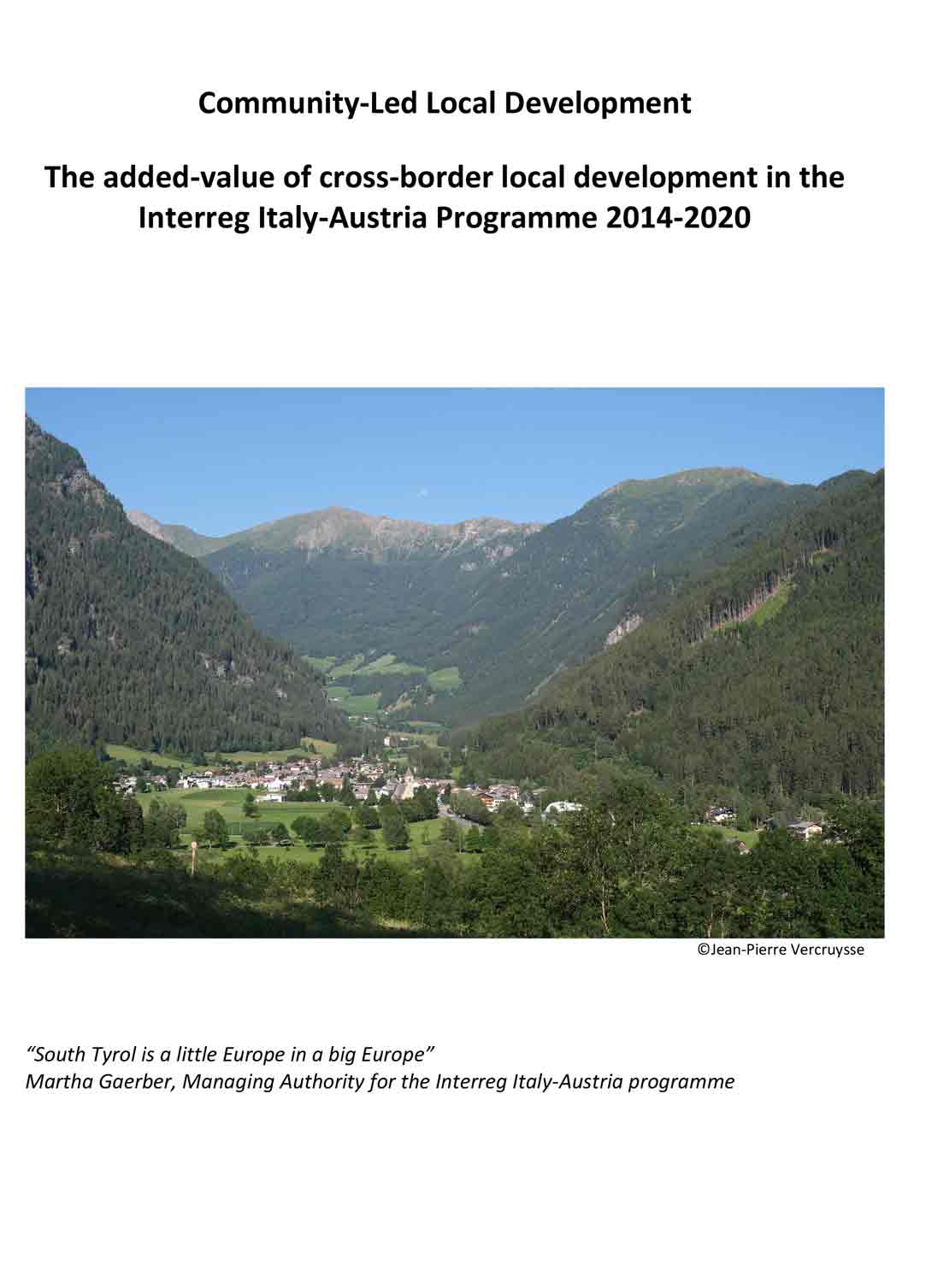Community-Led Local Development The added-value of cross-border local development in the Interreg Italy-Austria Programme 2014-2020

Studies
Date: 15 sep 2022
Period: 2014-2020
Theme: Cooperation between regions and countries, EU Strategy for the Alpine Region
Languages: en
Community-Led Local Development (CLLD) has been applied in European policy since the early 1990s, when the European Commission launched the LEADER Initiative. This reflected the fact that innovative approaches to local development, prioritising local knowledge to address local problems with local solutions, was gaining growing importance across the world.
Since 2014, CLLD is a special delivery mechanism for the European Structural and Investment Funds and the European Agricultural Fund for Rural Development (EAFRD). It devolves the selection of projects to the local level on the assumption that local communities know best what is good for their development.
Interreg is one of funds in which CLLD is used to support and finance cross-border projects by Local Action Groups. CLLD has only been applied since 2014 in the Italy-Austria (IT-AT) Interreg programme.
This report assesses the added-value that this method brings to local cross-border territories and highlights the results in order to support the upscaling of bottom-up and participatory approaches in Interreg. The report presents the results of a study-visit undertaken in July 2022 on the ground in the cross-border area between Italy and Austria. 42 meetings were undertaken with the Regional Authority in Austria and the Managing Authority in Bolzano, as well as on the ground in the four cross-border CLLD areas.
An important success factor is the common history which is still relevant today since the regions were unified at the end of World War I. Today these cross-border regions benefit from a large autonomy from the two capitals which creates an environment conducive for local development through local projects.
Multi-level governance arrangements in the framework of the IT-AT Interreg programme are complex because of their cross-border dimension. Many bodies are involved, including the Managing Authority, the Joint Secretariat, four Regional Coordination Units, mainstream agencies in charge of sectoral policies, and LEADER groups. This leads to coordination difficulties, and the need to work in two languages.
Recommendations for the future include: use the Draft Budget instead of reimbursement of eligible costs; adopt a monitoring system specific to Interreg; support the participation of the teams of the different administrations in LAG’s meeting; foster the use of Functional areas to address current limitations; and overcome language difficulties by training the teams.
The delivery mechanism is presented in detail, highlighting the difficulties and bottlenecks which create a high level of administrative burden and make the use of CLLD unattractive for stakeholders and potential beneficiaries. It is also necessary to show a high level of accountability for the use of public funds. Solutions such as the use of Draft Budget and other types of Simplified Cost Options are recommended as well as the streamlining of the monitoring and evaluation system.
The added-value of CLLD is assessed quantitatively by using monitoring data such as the number of projects financed by the LAGs or the amount of EU Funds disbursed. The level of commitment had reached 87% by August 2022 but the payments are taking place at a slower rate. The balance between small and medium projects varies between the LAGs, depending on both their experience and strategy.
The qualitative added-value is also analysed by looking at the way the specific features of CLLD are applied in the programme and on the ground.
- The area-based approach is implemented across the border, which is very innovative for CLLD. The use of Functional Areas in the next period could help solving some issues related to the size of the areas covered.
- The bottom-up approach is implemented mainly by the use of thematic working groups by the LAGs. These are used for the development of new strategies and oversee the implementation of thematic projects.
- The partnership approach is implemented through the setting-up of cross-border project selection committees but also by the obligation to include a partner from each Member State in each project.
- The strategy is the tool used to integrate the different dimension of the local development intervention. Current strategies are structured along the Europe 2020 strategy and will be taking into account the Green Deal in the next period. Strategies should be developed in a participative way, involving the local population in the assessment of the local needs.
- The innovative dimension should be defined locally and can be found in each project. Different types of local innovation are applied by the LAGs, including technological innovation, product innovation and innovation to add value to a local asset. The lack of networking is an obstacle to the dissemination of innovative ideas and approaches.
- Networking should be reinforced in future programmes to allow for sharing of project ideas but also problems and solutions related to the administrative burden. Technical assistance for networking should be provided for in the next period.
- Cooperation is fundamental to Interreg and takes place in each project supported by the LAGs, either as common actions or just as exchanges between stakeholders on both sides of the border.
- The devolution of decision-making on projects is applied, although it is made more difficult by the administrative burden which detracts the LAG’s teams from their core task of animating the local area.
The report includes a description of the four LAGs and their areas, as well as a short presentation of 34 cross-border projects financed by the LAGs.
